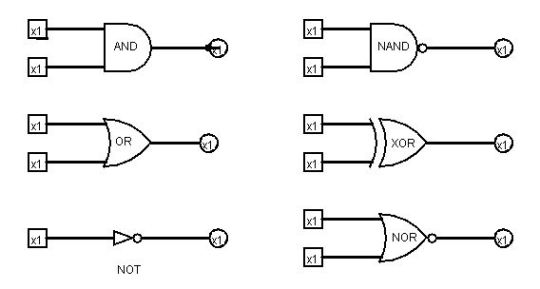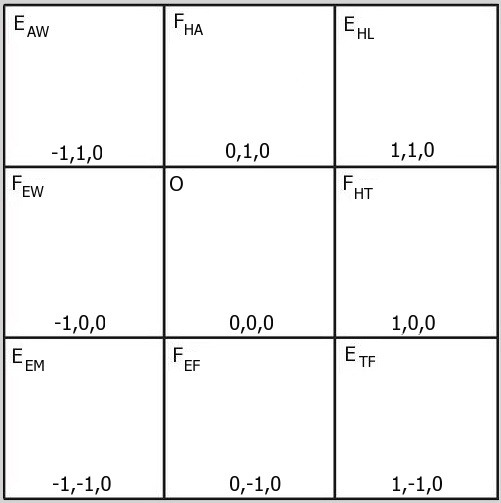#worldview
“As soon as any philosophy begins to believe in itself, it always creates the world in its own image. Thus, philosophy is the tyrannical drive itself, the most spiritual will to power.”
—F. Nietzsche, Beyond Good and Evil, §9 (edited excerpt).
Beyond Descartes - Part 10
Taoism Meets Boolean Logic: Introduction

Logic gate symbols
(continued from here)
Before we can hope to comprehend Taoist arithmetic and geometry we need to take a short detour through Boolean logic. First and foremost, we need to see how Boolean logic[1] relates to Cartesian coordinates. That will provide what may be the best foundation available for understanding the Taoist approach to mapping of spacetime and the methodology which mandalic geometry derived from it.[2]
For Descartes, his coordinate system is one thing, his coordinate geometry another. For Taoism, the coordinate system is the geometry.[3] Boolean logic helps to explain how the two perspectives are similar, how different. Cartesian coordinates are static and passive. Taoist coordinates and the derivative mandalic coordinates are active and dynamic. In brief, the latter are changeable and self-changeable, a feat carried out by means of a brand of Boolean logic intrinsic to the system. Although it is true that Descartes’ coordinates do encode much the same information, that is not where their focus of interest lies. Accordingly they turn our own attention elsewhere and we overlook those inherent possibilities.[4]
Descartes’ geometric system is one based on vectors, that is, on both magnitude and direction. But in the scheme of things, the former has somehow eclipsed the preeminence of the latter in the Western hive mind. The opposite is true of Taoist thought and of mandalic geometry. Direction is uniformly revered as primary and prepotent. Magnitude, or scale, is viewed as secondary and subordinate. This mindset allows the Boolean nuances inherent in the system to come to the fore, where they are more easily recognized and deployed.
From such small and seemingly insignificant differences ensue entirely disparate worldviews.
(continuedhere)
Notes
[1] George Boole’s monumental contribution to symbolic logic was published in 1854 but was viewed as only an interesting academic novelty until the second decade of the twentieth century, when it was at last exhumed as a mathematical masterpiece by Whitehead and Russell in their Principia Mathematica.
[2] In Boolean logic (Boolean algebra) logical propositions are represented by algebraic equations in which multiplication and addition (and negation) are replaced with ‘and’ and 'or’ (and 'not’), and where the numbers '0’ and '1’ represent 'false’ and 'true’ respectively. Boolean logic has played a significant role in the development of computer programming and continues to do so.
[3] This is true also of mandalic geometry in its current formulation.
[4] This might be a proper place to proclaim that nature has little use for Descartes’ breed of coordinates, finding them far too stagnant and limiting for her purposes. Fortuitously, she devised her own choice coordinate stock long before Descartes thought to invent his.
© 2015 Martin Hauser
Please note: The content and/or format of this post may not be in finalized form. Reblog as a TEXT post will contain this caveat alerting readers to refer to the current version in the source blog. A LINK post will itself do the same. :)
Scroll to bottom for links to Previous / Next pages (if existent). This blog builds on what came before so the best way to follow it is chronologically. Tumblr doesn’t make that easy to do. Since the most recent page is reckoned as Page 1 the number of the actual Page 1 continually changes as new posts are added. To determine the number currently needed to locate Page 1 go to the most recent post which is here. The current total number of pages in the blog will be found at the bottom. The true Page 1 can be reached by changing the web address mandalicgeometry.tumblr.com to mandalicgeometry.tumblr.com/page/x, exchanging my current page number for x and entering. To find a different true page(p) subtract p from x+1 to get the number(n) to use. Place n in the URL instead of x (mandalicgeometry.tumblr.com/page/n) where
n = x + 1 - p. :)
-Page 293-
Quantum Naughts and Crosses Revisited - IV
The Cube Sliced and Diced
Cartesian Series: Section FHE


(continued from here)
Below we have the second of three frontal sections through the 3-cube, labeled with the Cartesian coordinates of each point. This “slice” is through a plane that lies between an identity face, which contains the trigram HEAVEN, and an inversion face with the trigram EARTH. As such it does not belong fully to either the one or the other, but it shares some characteristics of both. It is a plane, then, of mediation. Again we see here nine Cartesian ordered triads. Due to an artifact of the “slicing” procedure, the four edge centers deceptively appear as though vertices, and the four face centers could be taken as edge centers. Make note that these appearances are illusory. At the center of this section we have the origin point of the cube, Cartesian (0,0,0).[1]
The key to labeling of points in this section[2] and all those to follow can be found here.

Section FHE
(continuedhere)
Notes
[1] It might be well to note here that the origin point of the coordinate system never appears in either an identity plane or an inversion plane of any of the three section types. All of the planes in which it appears are mediation planes of three dimensions in the case of the Cartesian 3-cube, or of six dimensions in the case of the hybrid mandalic 6D/3D hypercube. This is likely the rationale for why in the I Ching a change involving passage through this central point is referred to as "crossing the Great Water.“ There must be more than coincidence in the fact that Western thought refers to this point as the "origin” and Taoist thought views it as the source and beginning of all things. It’s not that something important was lost in translation. The two notions arose independently, from two very different worldviews. Somehow in the scheme of things, the West came to equate “origin” with "zero" whereas the East came to equate "origin" with “the beginning and end of all things.” Taoism, in particular, sees in this a focus of both creation and dissolution. As we shall soon enough discover, this alternative perspective leads to a different species of arithmetic, one of great antiquity though long lost in the sands of time. Mandalic geometry has unearthed it and will reveal it here, in this blog, for the first time in millennia. As a teaser, it involves a different treatment of what the West calls “zero”. It is an arithmetic more in line with Boolean logic.
[2] The 2-dimensional version of this section is obtained from the x and y coordinates, which by convention are the first and second, respectively, in the Cartesian ordered triads seen here. So the only difference between this section and the FHsectionpreviously viewed is the fact that the z-coordinates here are all zero (0) instead of +1. In our next section, FE, the x and y coordinates will again be as seen here but all z-coordinates will be -1. I believe I detect a trend developing here.
© 2015 Martin Hauser
Please note: The content and/or format of this post may not be in finalized form. Reblog as a TEXT post will contain this caveat alerting readers to refer to the current version in the source blog. A LINK post will itself do the same. :)
Scroll to bottom for links to Previous / Next pages (if existent). This blog builds on what came before so the best way to follow it is chronologically. Tumblr doesn’t make that easy to do. Since the most recent page is reckoned as Page 1 the number of the actual Page 1 continually changes as new posts are added. To determine the number currently needed to locate Page 1 go to the most recent post which is here. The current total number of pages in the blog will be found at the bottom. The true Page 1 can be reached by changing the web address mandalicgeometry.tumblr.com to mandalicgeometry.tumblr.com/page/x, exchanging my current page number for x and entering. To find a different true page(p) subtract p from x+1 to get the number(n) to use. Place n in the URL instead of x (mandalicgeometry.tumblr.com/page/n) where
n = x + 1 - p. :)
-Page 289-
Beyond Descartes - Part 6
The Fiction Formerly Known As the Line


(continued from here)
Rereading the last post a moment ago I see I fell into the same old trap, namely describing a concept arising from an alternative worldview in terms of our Western worldview. It is so astonishingly easy to do this. So it is important always to be on guard against this error of mind.
In saying that the Taoist number line is the basis of its coordinate system I was phrasing the subject in Western terminology, which doesn’t just do an injustice to the truth of the matter, it does violence to it, in the process destroying the reality: that within Taoism, the coordinate system is primary. It precedes the line, which follows from it. What may be the most important difference between the Taoist apprehension of space and that of Descartes lies encoded within that single thought.
Descartes continues the fiction fomented in the Western mind by Euclid that the point and the line have independent reality. Taking that to be true, Descartes constructs his coordinate system using pointsandlines as the elemental building blocks. But to be true to the content and spirit of Taoism, this fabrication must be surrendered. For Taoism, the coordinate system, which models space, or spacetime rather, is primary. Therefore to understand the fictional Taoist line we must begin there, in the holism and the complexity of its coordinate system where dimension, whatever it may be, reigns supreme.[1]
And that means we can no longer disregard composite dimension, postponing discussion of it for a later time, because it is the logical basis on which the I Ching is predicated. It is related to what we today know as combinatorics,Boolean algebra, and probability, and is what gives rise to what I have called the plane of potentiality. It is the very pith of mandalic geometry, what makes it a representation of mandalic spacetime.[2]
(continuedhere)
Notes
[1] In my mind, dimension is a category of physical energetic description before it is a category of geometrical description. When particle physicists speak about “quantum numbers” I think they are actually, whether intended or not, referring to dimensions. If this is true, then our geometries should be constructed to reflect that primordial reality, not arbitrarily as we choose.
[2] In speaking of logic and the I Ching in the same breath I am using the term in its broadest sense as any formal system in which are defined axioms and rules of inference. In reference to the I Ching, the logic involved is far removed from the rationalism bequeathed to Descartes by his times. It is a pre-rationalist logic that prevailed in human history for a very long time before the eventual splitting off of the irrational from the rational. This means also that the I Ching is among other things a viable instrument to access strata of human minds long dormant in historical times, other than possibly, at times, in poetry and art and the work of those select scientists who make extensive use of intuition in the development of their theories.
Note to self: Two contrasting systems of thought based on very different worldviews can never be adequately explained in terms of one another. At times though, for lack of anything better, we necessarily fall back on just such a strategy, however limited, and make the best of it we can.
© 2015 Martin Hauser
Please note: The content and/or format of this post may not be in finalized form. Reblog as a TEXT post will contain this caveat alerting readers to refer to the current version in the source blog. A LINK post will itself do the same. :)
Scroll to bottom for links to Previous / Next pages (if existent). This blog builds on what came before so the best way to follow it is chronologically. Tumblr doesn’t make that easy to do. Since the most recent page is reckoned as Page 1 the number of the actual Page 1 continually changes as new posts are added. To determine the number currently needed to locate Page 1 go to the most recent post which is here. The current total number of pages in the blog will be found at the bottom. The true Page 1 can be reached by changing the web address mandalicgeometry.tumblr.com to mandalicgeometry.tumblr.com/page/x, exchanging my current page number for x and entering. To find a different true page(p) subtract p from x+1 to get the number(n) to use. Place n in the URL instead of x (mandalicgeometry.tumblr.com/page/n) where
n = x + 1 - p. :)
-Page 282-
Beyond Descartes - Part 4
Directional Locatives


(continued from here)
Descartes derives his directional locatives from considerations of human anatomy, as does most of Western culture. The descriptive terms generally used for orientation purposes include left/right;up/down; and forward/backward.[1] The first two sets have been extended also to refer to the cardinal directions, North/South and East/West.
To the degree that they conform to Cartesian coordinates, mandalic coordinates adhere to this schema as well. However, mandalic geometry and the Taoist I Ching upon which it is largely based constitute a system of combinatorial relationships that is rooted mainly in radial symmetry rather than bilateral symmetry. For mandalic coordinates, the principal directional locatives can be characterized as divergentandconvergent, and the principal movements or changes in position, as centrifugalandcentripetal.[2]
One of the important consequences of this alternative geometric perspective is that the frame of reference as well as the complex pattern produced are more integrative than in the method of Descartes. Looked at another way, Descartes is most enamored by specification of location of individual points whereas mandalic geometry is more concerned with relationships of parts - and the overall unification of the entire complex holistic system.[3]
From this one seemingly small difference an enormous disparity grows in a manner reminiscent of chaos theory.[4] Cartesian coordinates and mandalic coordinates can be made commensurate, but remain after all two exclusive systems of spatial awareness, leading to very disparate results arising out of what seem small initial differences.[5]
(continuedhere)
Image (bottom): Animation of a double compound pendulum showing chaotic behaviour. By Catslash (Own work). [Public domain], via Wikimedia Commons.[6]
Notes
[1] Such terminology is of little use, despite its biological origins, to an amoeba or octopus, not to mention those extraterrestrials who have been blessed with a second set of eyes at the back of their heads. (We wuz cheated.)
[2] To be more correct, the radial symmetry involved is of a special type. It is not simple planar radial symmetry, nor even the three-dimensional symmetry of a cube and its circumscribed and inscribed spheres. It is all of those but also the symmetry involved in all the different faces of a six-dimensional hypercube and the many relationships among them.
[3] To be fair, Descartes eventually gets around to relating his points in a systematic whole we now know as analytic geometry (1,2). But as great an achievement though it might be, Cartesian geometry lacks the overarching cosmographical implications which characterize mandalic geometry and the I Ching. Descartes’ system is purposed differently, arising as it does out of a very different world view. To paraphrase George Orwell,
“All geometries are sacred, but some geometries are more sacred than others.”
[4] Chaos theory was summarizedbyEdward Lorenzas:
“When the present determines the future, but the approximate present does not approximately determine the future.”
[5] An example of one unique result of mandalic coordination of space is the generation of a geometric/logical probability wave of all combinatorial elements that occur in the 6D/3D hybrid composite dimension specification of the system. I envision this as offering a possible model at least, if not an actual explanation, of the probabilistic nature of quantum mechanics. Extrapolating this thought to its uttermost conclusion, it is not entirely inconceivable, to my mind at least, that probability itself might be the result of composite dimensioning. (And for such a brash remark I would almost surely be excommunicated from the fold were I but a member.)
[6] Starting the pendulum from a slightly different initial condition would result in a completely different trajectory. The double rod pendulum is one of the simplest dynamical systems that has chaotic solutions. [Wikipedia]
© 2015 Martin Hauser
Please note: The content and/or format of this post may not be in finalized form. Reblog as a TEXT post will contain this caveat alerting readers to refer to the current version in the source blog. A LINK post will itself do the same. :)
Scroll to bottom for links to Previous / Next pages (if existent). This blog builds on what came before so the best way to follow it is chronologically. Tumblr doesn’t make that easy to do. Since the most recent page is reckoned as Page 1 the number of the actual Page 1 continually changes as new posts are added. To determine the number currently needed to locate Page 1 go to the most recent post which is here. The current total number of pages in the blog will be found at the bottom. The true Page 1 can be reached by changing the web address mandalicgeometry.tumblr.com to mandalicgeometry.tumblr.com/page/x, exchanging my current page number for x and entering. To find a different true page(p) subtract p from x+1 to get the number(n) to use. Place n in the URL instead of x (mandalicgeometry.tumblr.com/page/n) where
n = x + 1 - p. :)
-Page 280-
Earlier to Later Heaven: Fugue V Alchemy Is Not a Dirty Word


(continued from here)
As is the case with all great mysteries, many different explanations for the origins of both the EARLIER and LATER HEAVEN arrangements of the trigrams have been proposed. In seeking plausible explanations, it is well to keep in mind what the worldview contextual origin of these two different arrangements might have been. The dates of their origins seem to be separated by thousands of years.[1] They grew out of very different worldviews. Still there was a clear attempt to correlate LATER HEAVEN with EARLIER HEAVEN. At the time LATER HEAVEN appeared on the scene, there was a longstanding tradition in place which was not entirely discarded. A kind of conceptual amalgamation took place.[2] The mystery lies in how and why that was accomplished.
Alchemy in its most fundamental aspect has to do with all kinds of relationships and from such a perspective both Earlier Heaven and Later Heaven are alchemical in nature. But differently so. They are reflections of different ways of seeing reality. Both, however, are debilitated, in the sense that they are missing a third dimension. The trigram, having three Lines, is a combination form which maps three dimensions. It cannot be adequately represented by figures of one or two dimensions. Any attempt to do so inevitably provokes injustice to reality by misrepresenting all the combinatoric relationships possible among the eight trigrams.
Placing Earlier Heaven in context of three dimensions enables it to express the full range of relationships and changes that can occur among the eight trigrams, thereby creating a combinatoric system resembling a Boolean lattice. This is very likely the form in which Earlier Heaven was originally understood, whether explicitly or implicitly. At some stage of the development of Chinese philosophy, it lost its clear connection to the third dimension, possibly as a result of the new method of encoding and storing ideas in writing, which demanded linear text, displacing the older oral tradition. And that suggests a possible clue to the mystery of the two trigram arrangements.
(continuedhere)
Notes
[1] Both arrangements of the trigrams are of great antiquity, Earlier Heaven possibly dating to around 3000 BCE and Later Heaven to the 8th century BCE. The point here is that the two arose in widely different cultural contexts having differing worldviews with all that entails. Yet they were related one to the other in the Chinese mind. Imagine, if you will, say, the unlikely amalgamation of the phlogiston theory with the scientific oxygen theory of combustion or with modern thermodynamics in the West. How likely is it that such amalgamations could have occurred though the ideas involved were separated not by millennia but only a few centuries. Something very strange and unexplained happened in the history of Chinese thought when these two widely different arrangements of trigrams were entangled with one another. Things are not as they appear on the surface here. Something hermetic and profound is going on at a deeper level.
[2] Something similar did occur in the West when chemistry took over from alchemy. Though chemistry owes a debt to alchemy for its very existence it is somewhat in denial regarding its origins or at least about this particular aspect of its origins. Having alchemy in its family tree, however, is not something for chemistry to be ashamed about. Alchemy had been practiced in many parts of the world for several millennia before chemistry appeared and can boast many important accomplishments in the history of human cognition. It could be said chemistry threw out the baby with the bath water when it conclusively broke with alchemy, except that it never did do that, not completely. Alchemy in the broadest and best sense has to do with relationships of objects, one to another. Much the same can be said about chemistry.
Modern astronomy also pays homage to an earlier form of ideation when it invokes the notion of a constellation, a term first used in astrology which was considered a scholarly tradition throughout most of its history. Constellations in most cases are composed of stars which, though visible in the same general area, are often located at very different distances from Earth. Nonetheless the tradition of referring to constellations is still in use by astronomers today. Its expediency is considerable as any given point in a celestial coordinate system can easily and unambiguously be assigned to a constellation, 88 of which are officially recognized and used in modern astronomy. The past lives on, in the history of ideas, but changed.
© 2015 Martin Hauser
Please note: The content and/or format of this post may not be in finalized form. Reblog as a TEXT post will contain this caveat alerting readers to refer to the current version in the source blog. A LINK post will itself do the same. :)
Scroll to bottom for links to Previous / Next pages (if existent). This blog builds on what came before so the best way to follow it is chronologically. Tumblr doesn’t make that easy to do. Since the most recent page is reckoned as Page 1 the number of the actual Page 1 continually changes as new posts are added. To determine the number currently needed to locate Page 1 go to the most recent post which is here. The current total number of pages in the blog will be found at the bottom. The true Page 1 can be reached by changing the web address mandalicgeometry.tumblr.com to mandalicgeometry.tumblr.com/page/x, exchanging my current page number for x and entering. To find a different true page(p) subtract p from x + 1 to get the number(n) to use. Place n in the URL instead of x (mandalicgeometry.tumblr.com/page/n) where
n = x + 1 - p. :)
-Page 276-
Worldview - Finch and Fondu Page 66
Updates Bi-Weekly on Saturdays
Next
Project Worldview @alainaprana
Finch and Fondu comic written and drawn by @alainapranaand@little-noko
Like what you see? Please consider-Alaina’s Patreon Noko’s Patreon, MAIN STORE,REDBUBBLE,ETSYandDISCORD - thank you for your support!
Post link
Worldview - Finch and Fondu Page 68
Updates Bi-Weekly on Saturdays
Next
Project Worldview @alainaprana
Finch and Fondu comic written and drawn by @alainapranaand@little-noko
Like what you see? Please consider-Alaina’s Patreon Noko’s Patreon, MAIN STORE,REDBUBBLE,ETSYandDISCORD - thank you for your support!
Post link
WORLDVIEW - FINCH AND FONDU PAGE 67
Updates Bi-Weekly on Saturdays
Next
Project Worldview @alainaprana
Finch and Fondu comic written and drawn by @alainapranaand@little-noko
Like what you see? Please consider-
ALAINA’S PATREON NOKO’S PATREON, MAIN STORE,REDBUBBLE,ETSYANDDISCORD - THANK YOU FOR YOUR SUPPORT!
Post link
Commission I did for @alainaprana ! <33 Eira & John’s wedding along with Espresso & Madeleine cookies
GNOMED S2 EP04 is a masterpiece lol
O-Oh…. oh god. thank you so much!!! I absolutely love how you’ve drawn our babies in their wedding outfit ! They look absolutely adorable in your style !
Post link
Finally some update for my patreons… for those who receive monthtly wallpaper specifically. The first wallpaper of this month is a cookie run themed of the main characters of worldview, just a little something to warm up to drawing on my graphic tablet again since it’s been a while I touched it. I had a lot of fun with it. Especially finch and Jane’s cookie designs.
Art & Worldview© @little-noko&@alainaprana
Post link

I have another meta-analysis before getting into the plot content of The Midnight Gospel episodes. This time, I’m exploring the recurring motif of Clancy’s taking a pair of shoes with him as souvenirs of his trips to the virtual multiverse, again, highlighting as I did in my previous post that the planets and people he visits are indeed virtual.
But before getting into the shoes at the end of each episode, it is relevant to discuss how each episode begins. Clancy orders Computer, his home A.I., to bring up worlds for him to visit. After which, Clancy gets to choose from a series of custom avatars what he wants to look like for his trip.
The act of shopping for universes and customising exactly how you appear to the world is the epitome of convenience. Clancy isn’t just realising he can buy a product on the Internet instead of going to a store, he’s acquiring a planet and all its natural and artificial riches.
This isn’t a stretch either. Later on in the series, we meet a family of Multiverse Simulator farmers, who mine each world for its expensive artefacts and sell them for money in the tangible reality where the show takes place.
On top of that, each episode has a familiar flow, with Clancy entering the world, conducting his interview, and the world coming to its apocalyptic end, with Clancy hilariously getting caught up in the middle of things. Despite this, Clancy is in no real danger, because at any time he can summon Computer to take him back outside the simulator. Moreover, his body is safely in his home the entire time.
Then Clancy simply proceeds with the rest of his life. He uploads the space-cast and lets the view (yes, singular) roll in.
“Computer, do it NOW”

What’s striking is how transactional Clancy’s relationships with those around him are for majority of the show. He listens to his interviewees and offers them a modicum of respect, but that’s also because for the most part he finds himself agreeing with what they’re saying. The times he doesn’t like what he’s hearing, such as with David, there’s so much resistance, so much tuning out. It’s only David’s patience and gentle prodding that Clancy opens up enough to listen to what he has to say and calm down.
Two things to note on that. First, David is under no obligation to teach Clancy anything. He doesn’t have to put up with an angry octopus who just ruined his painting, came into his place, and started screaming at him. It just so happens that his personal philosophy makes it less likely for occurrences like that to faze him. Second, Clancy wasn’t planning on doing an interview with David. There’s a chance he wasn’t planning to do an interview at all. He was trying to get into the simulator to escape a call he did not want to hear.
Computer calls him out on it as well, saying,
It’s become clear to me that you’ve been avoiding dealing with the real world by going into my many universes.
All the while Clancy is talking over him with the same dismissive attitude, tuning out what advice Computer is giving, just like the phone call or voice messages he’s been avoiding.

Though we don’t know what Clancy’s life was before the events of the first episode, we do know that since then, he’s been living in a way that suited him. Doing the things he more or less enjoyed. Despite this, he still had responsibilities and generally, just things he didn’t want to do. The most evident in the episode was his severe neglect of Computer, causing the malfunctions that threw him into a fit of rage in the first place.
It’s in this episode that he finally interacts with people outside the simulator. We are introduced to his neighbours, the aforementioned simulator farmers, We meet Bryce, the fidgety Multiverse Simulator repairman. And his interactions with them are transactional. He calls on them because he needs something– a way to fix his simulator. He humours them because he thinks they can offer him what he wants, and when they didn’t, he left them immediately.
In my first post of The Midnight Gospel analysis playlist, I talked about how it was so easy to respond to your own need to be comfortable and satisfied because your needs are immediate and urgent to you. You feel them and when you don’t answer them they gnaw at you and caw at the back of your mind until you satiate them.
I want to emphasise that the harm is not that we are born self-centred. No, that’s a fact of life. We need to take care of ourselves as individuals before we can function in the world we live in. It’s a survival instinct. It becomes problematic when self-preservation and self-comfort are where we stop.
It’seasy to focus on yourself and only yourself, forever. It’s convenient. On top of that, it’s enabled by all our new technology. In the show, it’s having a semi-sentient home A.I. and a multiverse simulator to escape to and profit from.
There are a lot of parallels to this in our world. Digital spaces, personalised content, economic privilege. In these cases, you can just stay in your comfy warm bubble and never leave it.
The Extreme Comfort Zone

Some concrete examples involve the consumption of media. I don’t want to sound like a crotchety old person and I’m not disparaging anyone. Something I’ve noticed, though, is how my younger family members only watch video streaming sites. Exclusively they watch content that caters to their very niche interests. This stands in stark contrast to when cable television monopolised home entertainment, because you couldn’t decide which shows would air and you couldn’t decide when they would air. You’d have to make an effort to make time for the series you wanted to watch, and in the act of waiting around for a show you were interested in, you’d stumble upon other channels, movies, or series that were interesting.
This is not to say that the democratisation of entertainment is a bad thing. I’m glad that people now have a greater say in the content they consume, they way my younger self did not, and I’m glad people have more spaces to share their niche interests in a way my younger alienated self could only have dreamed. However, this setup brings to the forefront our very transactional relationship with not only mainstream media but individual and independent content creators.
Watching movies is another example. In a theatre, you either sit through an entire movie or you walk out if it’s too unbearable. If a scene is too tense or suspenseful, you have no way of knowing whether or not you’re close to the end or if there will even be a happy resolution.
A habit I’ve noticed with family and friends, especially the younger ones, easily lets me know when they’re bored or uncomfortable. When we’re watching a video or streaming a movie, they’ll tap on the screen to see how much time is left in the running.

And there’s an underlying message to that. If what we’re seeing or hearing isn’t something tailored to our specific interests, then it’s not worth consuming. If it’s too long, then I didn’t read it. If the art is kind of weird, then it’s not enough to keep watching, no matter the message. (This is real. I know people who tell me they refuse to watch a show like Adventure Time or BoJack Horseman or anyanime because they don’t like the art).
It’s perfectly within one’s rights to skip to end of a book or a film. Life is short. We’re always busy. The modern world has a lot of demands and sometimes you just want to turn off your brain and enjoy something.
But on the rare days you have free time and energy to spare, you can venture outside the realm of what is reassuring and self-affirming. Yes, you can stay in the extreme comfort zone because you don’t have to leave it. You don’t haveto face other people or be confronted by things that make you second-guess your entire way of thinking. But I think you should. Not every moment of every day, because that gets tiring. But once in a while, definitely.
Now how does this all tie back to The Midnight Gospel?
Walking in Virtual Shoes

When we get deeper into his backstory, we find out that Clancy has been running away. He’s been refusing to face the relationships confronting him. Like his sister. Talking to her on the phone, she tells him he can’t just keep starting over without facing himself, and it leads him to an angry meltdown in the David episode.
If our worldviews are never challenged, if we are always in our comfort zone, then we never have a reason to turn outward. Because the default setting is to focus on ourselves.
But Clancy does encounter people who regularly challenge his worldview. Even if they’re created by a computer program. And he listens to them. Some more easily than others, but in every episode, eventually, he listens. And they, in turn, affect his emotions and changes the decisions he makes in life.
Again, this is nothing against the younger generations or against current technology. Because I think every generation is guilty of this: Retreating into a comfortable worldview where we don’t realise what other people go through, or don’t think that other people are capable of understanding us. It’s incredibly isolating. In the end, it leads to so much frustration and dissatisfaction, that when our bubble is even slightly threatened, we’re sent into an angry meltdown much like Clancy was.
So, I think it’s very poignant that at the end of every episode, Clancy always manages to take a shoe or two back with him, and these are what he keeps as souvenirs of his trip. This recurring image is significant.
There’s that idiom about walking a mile in someone else’s shoes. Though I think it relates to The Midnight Gospel tangentially, I don’t think it’s exactly what the metaphor of the shoe in each episode means. Clancy doesn’t always take the shoes from the interviewee of the episode. Sometimes it’s just a random shoe he finds on the ground. Sometimes, he takes it from another character. In the last episode, the shoes were pretty much handed to him.

Therefore, I wouldn’t say that Clancy is walking a mile in someone else’s shoes. In fact, in every episode, Clancy remains distinctly Clancy. Each of his avatars have his same color scheme, his eyes, and even his signature hat. During the interviews, he interjects with his own opinions and experiences.
That’s the essence of active engagement with the world, including other people and the media we consume. We listen and then measure it against our own beliefs and values. We re-examine ourselves but that entails having a self to re-examine in the first place.
The shoes represent stepping, quite literally, outside your comfort zone. Even when we’re sitting at home or comfortably, we’ll probably be wearing clothes. But we don’t need to wear shoes if we don’t have to.
The meta is supported by Clancy’s character always presented as being barefoot. In his current lifestyle, he doesn’t need to interact with anyone else. He doesn’t need to do most things he doesn’t want to. He doesn’t need to challenge himself. But in the end, he chooses to, whether he realises or not. Just being open to what the world has to say, especially the people in it, is enough of a first step.
So, to me, the shoes represent having to make that conscious effort of having to put on shoes and go outside. It’s a decision to engage instead of disengaging and curling up inside yourself. You can’t just be thrust into that, or accidentally end up with shoes on and find yourself outside.
——————————————————————————————-
If you enjoyed this post, you might enjoy my other analyses in The Midnight Gospel playlist:
- Some Thoughts: The Midnight Gospel Trailer
- The Midnight Gospel Analysis 01: What’s real and does it matter?
I’ll continue to link to future Midnight Gospel analyses as they come. And as always, my ask box is open.
The Tao of Terence: Beyond “Existentialism”
I learned of Terence McKenna (1946-2000) on September 14, 2012, when I was 29 years old. It was the day after I had completed the main final draft of Taipei, my first book to include psychedelics and which ends with a scene in which a character wonders if he has died after eating psilocybin mushrooms. I was in my room, zombielike and depressed after a period of time embodying a “whatever it takes” attitude regarding amphetamine use and completing my book. I had somewhat randomly clicked a YouTube video in which Joe Rogan (whom I was vaguely aware of as the host of Fear Factor, the TV show, a long time ago) was aggressively, excitedly talking about DMT, a neurotransmitter-like, illegal, psychedelic compound found in human (and other animal) brains and in at least ~50 species of plants worldwide. I did not have firsthand experience with DMT at the time, and had only read about it online.
At one point Joe Rogan began referencing someone in a “if you think I sound crazy, listen to this other guy” manner. He was talking about Terence McKenna, a person who would smoke DMT and, after ~15 seconds, without fail, find himself in an “unanticipated dimension” infested with “self-transforming machine elves”—also called “fractal elves,” “self-dribbling jeweled basketballs,” or “little self-transforming tykes”—that spoke English and a kind of visible language while jumping into and out of his body, “running around chirping and singing.” These entities, which McKenna described in a word as “zany,” were maybe either “dead people” in “an ecology of souls,” “human beings from the distant future,” or things with their own hopes, fears, problems that inhabit a parallel universe.
Post link







